Contemporary Church History Quarterly
Volume 21, Number 4 (December 2015)
Review of Mark Riebling, Church of Spies: The Vatican’s Secret War against Hitler (New York: Basic Books, 2015), 375 Pp. ISBN 9780465022298.
By Mark Edward Ruff, St. Louis University
That Pope Pius XII was involved in several failed plots to kill Hitler has been publicly known since the 1960s, if not since the close of the Second World War. But there have been few investigations into the actual cloak and dagger. Mark Riebling’s methodically-researched detective story, cast in the genre of a thriller, deserves widespread attention for the light that it sheds on this clandestine world of intrigue and terror in which the pontiff played a central role.
 In the detail given to the spy rings operating out of the Vatican, Riebling’s account goes far beyond earlier accounts like those of the American scholar, Harold Deutsch. It adduces evidence from published documentary collections, state, church and intelligence archives in Britain, Germany, Poland and the United States as well as the extensive interview transcripts found in Harold Deutsch’s papers in Carlisle, Pennsylvania. In light of the fragmentary nature of the evidence and the sheer volumes of conspirators, adversaries and agendas, this research is one that only a historian of intelligence could have pulled off so compellingly. Shaping the contours of this book is Riebling’s broad range of experiences as an editor for Random House, security expert and terrorist analysis. This is simply the finest work on the subject in print.
In the detail given to the spy rings operating out of the Vatican, Riebling’s account goes far beyond earlier accounts like those of the American scholar, Harold Deutsch. It adduces evidence from published documentary collections, state, church and intelligence archives in Britain, Germany, Poland and the United States as well as the extensive interview transcripts found in Harold Deutsch’s papers in Carlisle, Pennsylvania. In light of the fragmentary nature of the evidence and the sheer volumes of conspirators, adversaries and agendas, this research is one that only a historian of intelligence could have pulled off so compellingly. Shaping the contours of this book is Riebling’s broad range of experiences as an editor for Random House, security expert and terrorist analysis. This is simply the finest work on the subject in print.
At the heart of Riebling’s sleuthing are three plots in which Pius XII served as an intermediary between German plotters and British diplomats with whom he held midnight meetings. The Vatican, he makes clear, was one of the world’s oldest spy services. He tells how Pius XII had Guglielmo Marconi, the inventor of the radio, secretly install a secret audio recording system. Such technical expertise notwithstanding, all three plots were unsuccessful or aborted. In late 1939 and 1940, German generals were supposed to assassinate Hitler, but both they and the British got cold feet. In 1943, two bottles of cognac filled with explosives failed to detonate on board Hitler’s airplane. In 1944, Stauffenberg’s bombs only wounded Hitler. Riebling describes the unraveling of these plots and their aftermath, a gruesome litany of interrogation, torture and execution.
In many ways, however, the star of the show is not the pontiff but a Bavarian lawyer and future co-founder of the CSU, Josef Müller. Pius himself features in less than half of the chapters; it is the world of the plotters, and most notably Müller, that takes center stage. From his home in Munich, Müller was one of the masterminds, a courier bringing reports of Nazi persecution of the churches to Robert Leiber, SJ and Monsignor Ludwig Kaas, an influential German Jesuit and the former Center Party leader residing in the Vatican. At the same time, Müller, though his base in the Abwehr, the military intelligence branch of the Wehrmacht, developed strong ties to well-known plotters like Wilhelm Canaris, Alfred Delp, SJ and Hans Oster, all of whom perished following the failure of the assassination plot of July 20, 1944. True to its genre as a historical thriller, this book closes with a final revelation, how Müller, languishing in concentration camps, was given a last-minute reprieve from the gallows.
Riebling makes it clear that this is largely a Catholic story, the Protestant theologian, Dietrich Bonhoeffer serving as the lone exception. The Catholic plotters quickly discovered that they could not persuade Lutherans in the highest ranks of the army and church to go against centuries-old traditions of obedience to state authority, those anchored in Romans 13 and Luther’s doctrine of the two kingdoms. Riebling somewhat mistakenly attributes these same understandings to Calvinists, claiming that Calvin too deferred to state authority. In reality, Calvinists had historically proven to be far more inclined to resist unjust political authority under the maxim from Acts 5:29 that “we ought to obey God rather than man.” But even so, the resistance front was gradually become ecumenical, a part of cooperation that would infuse the founding of the interconfessional CDU in 1945.
What is missing from Riebling’s account is a discussion of how credible his sources are. What might the motives of the postwar storytellers have been in recounting their role in these conspiracies and their failures? Almost by definition, writing the history of such conspiracies runs up against two fundamental problems. For obvious reasons, clandestine plotters tend not to leave behind written records such as letters and diaries. They destroy them or better yet, never commit their plans to paper. Interrogation transcripts produced by their captors are typically unreliable, frequently the product of torture and deprivation. Even worse: ex-intelligence agents are often notoriously prone to exaggeration. Some seek to bolster their accomplishments post facto or settle scores with one-time rivals and adversaries. Nearly all are influenced by the political and ideological climate in which they recount their stories.
Josef Müller provides the perfect illustration of these problems. Riebling relies on his postwar memoirs published in 1975 and a series of interviews carried out by Harold Deutsch at points in the 1950s and 1960s. But how reliable this testimony compiled twenty to forty years after the events in question had taken place was remains open to question. Müller’s account has to be read through the lens of his own postwar political career, one punctuated by both triumph and defeat. After co-founding the CSU, Müller found himself under fire from the conservative integralist wing of the party led by Alois Hundhammer. His political opponents, in the grossest of ironies, denounced him as a former Nazi, forcing Müller to undergo a humiliating ordeal of denazification before a tribunal in late 1946. Müller was also forced to step down from his position as Bavarian Minister of Justice in 1952, having been accused of illegally receiving 20,000 DM from a Jewish rabbi, Philipp Auerbach. He also lost a race in 1960 to become the mayor of Munich. The extent to which these subsequent events colored his recollections is unclear. He was obviously driven by the need to exonerate Pope Pius XII from the allegations raised by Rolf Hochhuth, Saul Friedländer and others that the pontiff had refused to actively resist National Socialism. He was also influenced by prevailing currents that as late as the 1970s continued to see the men of the resistance movements as traitors. Most perplexing is that one of his handlers and co-conspirators until his arrest in early 1941, the Bavarian cathedral canon, Johnannes Neuhäusler, maintained a public silence about these plots until his death. To be sure, Riebling’s account, intended in so small measure for a popular audience, cannot delve into these puzzles in all of their complexity. Nonetheless, weaving the story of the ambiguous sources into the larger narrative would have lent the author’s larger conclusions even greater credibility.
For Riebling ultimately shows that under the guise of silence, Pope Pius XII was working to undermine National Socialism. The silence, for which he has been excoriated by many since the premiere of Hochhuth’s play in February, 1963, was in fact necessary for his covert activities. Riebling quotes what Müller told Harold Tittmann, an American diplomat to the Vatican, on June 3, 1945. “His anti-Nazi organization had always been very insistent that the Pope should refrain from making any public statement singling out the Nazis and specifically condemning them and had recommended that the Pope`s remarks should be confined to generalities only” (248). Müller added that “if the Pope had been specific, Germans would have accused him of yielding to the promptings of foreign powers and this would have made the German Catholics even more suspected than they were and would have greatly restricted their freedom of action in their work of resistance to the Nazis.”
Yet Riebling does not let Pius off the hook completely. “Judging Pius by what he did not say,” he writes, “one can only damn him.” (28). He had the duty to speak out – and on the whole did not. “During the world’s greatest moral crisis,” he notes, “its greatest moral leaders seemed at a loss for words” (28). Nor does he exonerate German Catholics. That it was the pontiff who would have to become involved in such plots speaks volumes about the fact that too few Catholics lower in the hierarchy chose a course of opposition.
Riebling’s masterful account will long remain the definitive account of the papal involvement in the conspiracies to topple Hitler. Yet it cannot remain the final work, the Vatican not yet having made fully available the papers from the wartime pontificate of Pius XII.

 Correll begins with the court preacher Adolf Stoecker (1835-1909), who created the church networks and organizations that provided believing theologians and church leaders with a community of likeminded churchmen in which they could expound their modern conservative responses to the crisis of Protestantism at the turn of the century. Although Adolf Stoecker is best known for popularizing political anti-Semitism, his conservative political vision of a triumphant Germany, united in thrown and altar, and fending off Germany’s multiple enemies —Austria, France, Catholics, Socialists, Liberals, as well as Jews—appealed to more than just anti-Semites. While he saw the defeat of Austria in 1866 and France in 1870 as the beginning of a great awakening in Germany, he became increasingly disappointed that the Prusso-German leaders failed to rally the growing working-class to participate in this national and Protestant awakening. In addition to founding the Christian Social Workers’ Party to harness the poor for his conservative Christian cause, another central concern of his was to combat the threat of liberal or critical theology in the church, which was gaining ground at the time. To this end he founded the “Positive Union,” an organization bringing together believing church leaders, theologians, and pastors, with the purpose of maintaining control of the key leadership positions within the church and thereby limiting the destructive influences of liberal theology on the pastorate. While the Positive Union was mostly a success, his conservative and anti-Semitic political party never gained any traction among workers. Nor did his idea to do away with the state church and found an ultra-nationalist—albeit independent of the state—Volkskirche, which would work side-by-side with the state to further the cause of a conservative Christian Germany.
Correll begins with the court preacher Adolf Stoecker (1835-1909), who created the church networks and organizations that provided believing theologians and church leaders with a community of likeminded churchmen in which they could expound their modern conservative responses to the crisis of Protestantism at the turn of the century. Although Adolf Stoecker is best known for popularizing political anti-Semitism, his conservative political vision of a triumphant Germany, united in thrown and altar, and fending off Germany’s multiple enemies —Austria, France, Catholics, Socialists, Liberals, as well as Jews—appealed to more than just anti-Semites. While he saw the defeat of Austria in 1866 and France in 1870 as the beginning of a great awakening in Germany, he became increasingly disappointed that the Prusso-German leaders failed to rally the growing working-class to participate in this national and Protestant awakening. In addition to founding the Christian Social Workers’ Party to harness the poor for his conservative Christian cause, another central concern of his was to combat the threat of liberal or critical theology in the church, which was gaining ground at the time. To this end he founded the “Positive Union,” an organization bringing together believing church leaders, theologians, and pastors, with the purpose of maintaining control of the key leadership positions within the church and thereby limiting the destructive influences of liberal theology on the pastorate. While the Positive Union was mostly a success, his conservative and anti-Semitic political party never gained any traction among workers. Nor did his idea to do away with the state church and found an ultra-nationalist—albeit independent of the state—Volkskirche, which would work side-by-side with the state to further the cause of a conservative Christian Germany.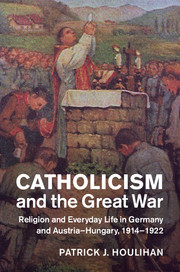 Houlihan’s argument is that conventional interpretations of religion in the First World War, which emphasize the secularizing effect of a shattering war experience as expressed in the voices of cultural modernists, do not capture the experiences of German and Austro-Hungarian Catholics. Rather, he asserts that Catholics adjusted to industrial warfare because their transnational faith and its practices helped them to cope relatively successfully with the upheaval and brutality of war—more successfully than Protestants, whose faith (in the case of Germany) was more closely tied to the defeated state.
Houlihan’s argument is that conventional interpretations of religion in the First World War, which emphasize the secularizing effect of a shattering war experience as expressed in the voices of cultural modernists, do not capture the experiences of German and Austro-Hungarian Catholics. Rather, he asserts that Catholics adjusted to industrial warfare because their transnational faith and its practices helped them to cope relatively successfully with the upheaval and brutality of war—more successfully than Protestants, whose faith (in the case of Germany) was more closely tied to the defeated state.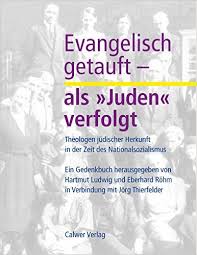 Evangelisch getauft—als “Juden” verfolgt is not a comprehensive history of this topic; nonetheless it is a valuable contribution to the literature. As its subtitle indicates, it is primarily a Gedenkbuch with brief biographies of 180 German Protestants whose lives were changed by the racial laws and the responses of their church. The editors have cast a wide net. The individuals profiled here include not only theologians and members of the Christian clergy, but individuals who were barred from studying theology before 1945 and others who, barred from other professions, decided to study theology in exile. Also included are teachers of religious education, Christians in “mixed” marriages, Austrians who came under Nazi law after 1938, and even several individuals who were Deutsche Christen or members of the Nazi party. While most of those profiled were members of the German Evangelical Church, there are also several profiles of individuals from Methodist, Baptist, and other free churches.
Evangelisch getauft—als “Juden” verfolgt is not a comprehensive history of this topic; nonetheless it is a valuable contribution to the literature. As its subtitle indicates, it is primarily a Gedenkbuch with brief biographies of 180 German Protestants whose lives were changed by the racial laws and the responses of their church. The editors have cast a wide net. The individuals profiled here include not only theologians and members of the Christian clergy, but individuals who were barred from studying theology before 1945 and others who, barred from other professions, decided to study theology in exile. Also included are teachers of religious education, Christians in “mixed” marriages, Austrians who came under Nazi law after 1938, and even several individuals who were Deutsche Christen or members of the Nazi party. While most of those profiled were members of the German Evangelical Church, there are also several profiles of individuals from Methodist, Baptist, and other free churches. In fact, Bonhoeffer’s participation in ecumenical affairs started immediately after his return in September 1931 from his visit to the United States. He was sent as a German youth delegate to a meeting in Cambridge of the World Alliance for Promoting International Friendship through the Churches. This body had originally been established in 1914, but had to suspend its activities during the war, and had only been resuscitated in 1920. Its support came from influential lay and clerical leaders, particularly in the democratic countries of Western Europe and North America. They recognized the need for programs of reconciliation and peace activities in order to bind up the wounds caused by the destructive violence of the recent war. It was here that Bonhoeffer met with such leading figures as the Anglican Bishop George Bell of Chichester, with whom he was to collaborate for the next decade.In fact, Bonhoeffer made such an impact that he was forthwith appointed as an Honorary Youth Secretary and given responsibility for the World Alliance’s youth work in central Europe. This was a challenge he could hardly refuse, and one to which he brought his newly-minted skills in theological advocacy and his energetic support of the World Alliance’s aims.
In fact, Bonhoeffer’s participation in ecumenical affairs started immediately after his return in September 1931 from his visit to the United States. He was sent as a German youth delegate to a meeting in Cambridge of the World Alliance for Promoting International Friendship through the Churches. This body had originally been established in 1914, but had to suspend its activities during the war, and had only been resuscitated in 1920. Its support came from influential lay and clerical leaders, particularly in the democratic countries of Western Europe and North America. They recognized the need for programs of reconciliation and peace activities in order to bind up the wounds caused by the destructive violence of the recent war. It was here that Bonhoeffer met with such leading figures as the Anglican Bishop George Bell of Chichester, with whom he was to collaborate for the next decade.In fact, Bonhoeffer made such an impact that he was forthwith appointed as an Honorary Youth Secretary and given responsibility for the World Alliance’s youth work in central Europe. This was a challenge he could hardly refuse, and one to which he brought his newly-minted skills in theological advocacy and his energetic support of the World Alliance’s aims. Heike Springhart’s Aufbrücke zu neuen Ufern is a detailed history and analysis of one such program, the partnership between the U.S. military government and German Protestant church leaders and organizations in Württemberg. Her focus is the work there of the U.S. Branch for Education and Religious Affairs (ERA) between 1946-1948, which she sets in a broader historical context by examining the individuals and organizations, both in the U.S. and in Germany, who during the war helped lay the theoretical and political foundation for the ERA’s work. There is also a concluding chapter that offers a conceptual framework for understanding the potential role of religion in post-conflict processes of democratization and social transformation, drawing on the German example as a case study.
Heike Springhart’s Aufbrücke zu neuen Ufern is a detailed history and analysis of one such program, the partnership between the U.S. military government and German Protestant church leaders and organizations in Württemberg. Her focus is the work there of the U.S. Branch for Education and Religious Affairs (ERA) between 1946-1948, which she sets in a broader historical context by examining the individuals and organizations, both in the U.S. and in Germany, who during the war helped lay the theoretical and political foundation for the ERA’s work. There is also a concluding chapter that offers a conceptual framework for understanding the potential role of religion in post-conflict processes of democratization and social transformation, drawing on the German example as a case study.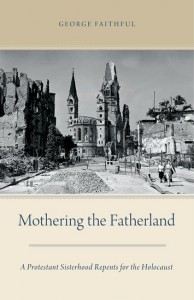 Mothering the Fatherland is a focused and sympathetic study of the life and work of a unique group of women who were so haunted by the Holocaust that, in the wake of the Second World War, they formed a Protestant sisterhood focused on intercessory repentance by the “true” Christians of Germany for the sins committed by the nation during the Third Reich. It is an absorbing work of historical theology that is especially significant for the effective manner in which the author situates the theology and practice of the sisterhood in their historical and intellectual contexts and for the author’s thoughtful analysis of the theology of the sisterhood’s co-founder.
Mothering the Fatherland is a focused and sympathetic study of the life and work of a unique group of women who were so haunted by the Holocaust that, in the wake of the Second World War, they formed a Protestant sisterhood focused on intercessory repentance by the “true” Christians of Germany for the sins committed by the nation during the Third Reich. It is an absorbing work of historical theology that is especially significant for the effective manner in which the author situates the theology and practice of the sisterhood in their historical and intellectual contexts and for the author’s thoughtful analysis of the theology of the sisterhood’s co-founder.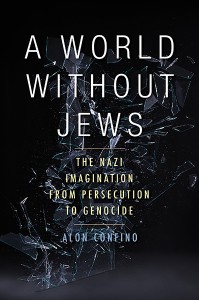
 The cover announces the character of the theme: it is the image of a stained glass window in Worcester Cathedral showing three resolute figures looking up towards the sky, intent, devout, broadly sanguine. One is a nurse and the other two are men of the Royal Navy and the Royal Air Force. The task that David Nash has set himself here is a striking one: in what kinds of narratives might the historian find the relationship between religious faith and active public life in the British twentieth century? How are we to locate the dimension of personal faith in the discussions and dramas of society at large? How are we to know when it is there – or when it is not?
The cover announces the character of the theme: it is the image of a stained glass window in Worcester Cathedral showing three resolute figures looking up towards the sky, intent, devout, broadly sanguine. One is a nurse and the other two are men of the Royal Navy and the Royal Air Force. The task that David Nash has set himself here is a striking one: in what kinds of narratives might the historian find the relationship between religious faith and active public life in the British twentieth century? How are we to locate the dimension of personal faith in the discussions and dramas of society at large? How are we to know when it is there – or when it is not?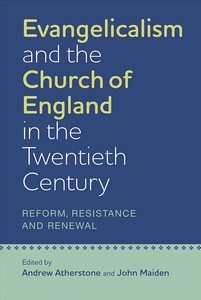 The opening chapter, written by two Oxford scholars, examines the taxonomy of recent English Evangelicalism, describing the various strands within this spectrum of belief, which share common features in their adherence to the key truths of justification by faith alone and the supreme authority of Holy Scripture as the word of God. Nevertheless each of these strands places its emphasis on different aspects of the faith. Conservative Evangelicals stress the inerrancy of the Bible and refuse to accept the scientific evidence for evolution. More “open” Evangelicals have accepted both the modern theories about the world’s origins and many of the findings of biblical criticism, while most recently the contribution of the charismatic movement, drawn from Pentecostalism, and found in such London churches as Holy Trinity, Brompton or St Paul’s, Onslow Square, has reinvigorated and popularized Evangelicalism among young people. The rivalries—and sometimes the acerbic criticisms of these groups of each other—have meant that English evangelicalism often seems to have been in a constant process of reconfiguration.
The opening chapter, written by two Oxford scholars, examines the taxonomy of recent English Evangelicalism, describing the various strands within this spectrum of belief, which share common features in their adherence to the key truths of justification by faith alone and the supreme authority of Holy Scripture as the word of God. Nevertheless each of these strands places its emphasis on different aspects of the faith. Conservative Evangelicals stress the inerrancy of the Bible and refuse to accept the scientific evidence for evolution. More “open” Evangelicals have accepted both the modern theories about the world’s origins and many of the findings of biblical criticism, while most recently the contribution of the charismatic movement, drawn from Pentecostalism, and found in such London churches as Holy Trinity, Brompton or St Paul’s, Onslow Square, has reinvigorated and popularized Evangelicalism among young people. The rivalries—and sometimes the acerbic criticisms of these groups of each other—have meant that English evangelicalism often seems to have been in a constant process of reconfiguration. Timothy Jones follows this lead by undertaking a study of the major changes in gender politics in the Church of England from the mid-nineteenth to the mid-twentieth century. He focusses on six episodes during this period which, he claims, demonstrated the often reluctant posture of the church leaders when challenged to take a stand on matters affecting gender or sexual politics. Over the course of this hundred year span, English society evolved rapidly and adopted a much more liberal stance, which was often reflected in parliamentary debates, and found its way into progressive legislation. The result was a frequent clash of interest with the more conservative and traditional sectors of opinion, including those of the Church of England. Jones begins his survey with the debates about marriage in the mid-1850s and concludes with the heated controversies about consensual homosexuality in the 1950s. Rather than indulging in detailing the reactionary attitudes of some Church of England leaders, Jones skillfully weaves into his account the variety of positions taken over the years, and displays a commendable sympathy for most of the participants in this on-going search for new understandings amongst church members about gender and sexual politics.
Timothy Jones follows this lead by undertaking a study of the major changes in gender politics in the Church of England from the mid-nineteenth to the mid-twentieth century. He focusses on six episodes during this period which, he claims, demonstrated the often reluctant posture of the church leaders when challenged to take a stand on matters affecting gender or sexual politics. Over the course of this hundred year span, English society evolved rapidly and adopted a much more liberal stance, which was often reflected in parliamentary debates, and found its way into progressive legislation. The result was a frequent clash of interest with the more conservative and traditional sectors of opinion, including those of the Church of England. Jones begins his survey with the debates about marriage in the mid-1850s and concludes with the heated controversies about consensual homosexuality in the 1950s. Rather than indulging in detailing the reactionary attitudes of some Church of England leaders, Jones skillfully weaves into his account the variety of positions taken over the years, and displays a commendable sympathy for most of the participants in this on-going search for new understandings amongst church members about gender and sexual politics. The Holy Land is of course full of holy history, also of holy geography. Stuhlmann sees his job as motivating his young guests from Europe to understand the dimensions of both these features and to encourage a courageous encounter with the many history-laced dilemmas which are met in so many corners of the “promised” land. He is clearly against the kind of religious tourism which brings Christian visitors to Israel, but seeks to isolate them in the first century without ever meeting with Israel’s present-day inhabitants or their troubles. He is equally opposed to the kind of narrow eschatological proclamation of certain Christian groups, especially some American evangelicals, or to the equally one-sided Jewish extremists who wage a continual battle against their Palestinian neighbours. He is grateful for the fact that he and his younger colleagues from Germany are now looked on as representatives of the “new Germany”, and that the horrors of the Holocaust, though loudly trumpeted in state-controlled media, are not attributed to the younger generation or to him personally. Likewise he is encouraged by the friendliness of the Palestinians who see these visitors from Europe as a hopeful sign that their cause is not being forgotten by the rest of the world. And he draws hope from the fact that there are many signs of confidence building between young Jews and Arabs, not least those established at Nes Ammim itself.
The Holy Land is of course full of holy history, also of holy geography. Stuhlmann sees his job as motivating his young guests from Europe to understand the dimensions of both these features and to encourage a courageous encounter with the many history-laced dilemmas which are met in so many corners of the “promised” land. He is clearly against the kind of religious tourism which brings Christian visitors to Israel, but seeks to isolate them in the first century without ever meeting with Israel’s present-day inhabitants or their troubles. He is equally opposed to the kind of narrow eschatological proclamation of certain Christian groups, especially some American evangelicals, or to the equally one-sided Jewish extremists who wage a continual battle against their Palestinian neighbours. He is grateful for the fact that he and his younger colleagues from Germany are now looked on as representatives of the “new Germany”, and that the horrors of the Holocaust, though loudly trumpeted in state-controlled media, are not attributed to the younger generation or to him personally. Likewise he is encouraged by the friendliness of the Palestinians who see these visitors from Europe as a hopeful sign that their cause is not being forgotten by the rest of the world. And he draws hope from the fact that there are many signs of confidence building between young Jews and Arabs, not least those established at Nes Ammim itself.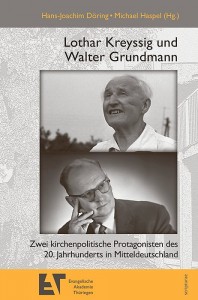 Anke Silomon’s introductory chapter provides biographical details about both men. Even though she relies on already published research, the author does give a survey of their careers, which will be of value to those readers not familiar with the subject. Both men were born during the reign of the last Kaiser, and their careers spanned the whole period up to and including the time of the German Democratic Republic, i.e. after 1949. This is followed by an article by Oliver Arnhold, who in 2010 published a comprehensive study of the “German Christians” as well as of the Eisenach Institute, which took the title of“The Institute for the Research and Removal of Jewish influence on German church life”. This contribution was drawn from a lecture Arnhold gave in 2014, which was subsequently included in this volume, and concentrated primarily on the ill-fated Institute. Hence unfortunately this means that his portrait of Walter Grundmann, who is supposed to be the main topic of this volume, is too condensed.
Anke Silomon’s introductory chapter provides biographical details about both men. Even though she relies on already published research, the author does give a survey of their careers, which will be of value to those readers not familiar with the subject. Both men were born during the reign of the last Kaiser, and their careers spanned the whole period up to and including the time of the German Democratic Republic, i.e. after 1949. This is followed by an article by Oliver Arnhold, who in 2010 published a comprehensive study of the “German Christians” as well as of the Eisenach Institute, which took the title of“The Institute for the Research and Removal of Jewish influence on German church life”. This contribution was drawn from a lecture Arnhold gave in 2014, which was subsequently included in this volume, and concentrated primarily on the ill-fated Institute. Hence unfortunately this means that his portrait of Walter Grundmann, who is supposed to be the main topic of this volume, is too condensed.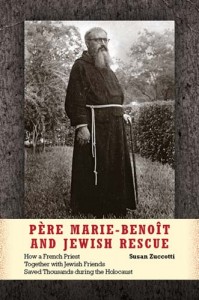 Susan Zuccotti is an established American scholar who has written a number of studies of the Holocaust, particularly dealing with events in France and Italy. Her latest contribution provides us with a well-researched biography of a little-known French Capuchin friar, Fr. Marie-Benoît, who was to play a significant role in rescuing Jews first in Marseilles in 1942 and then in Rome in 1943-4. Although he was to live for several decades after the war, his exploits were only recorded in French and remained largely unnoticed in remote French archives. Zuccotti was able to interview him in 1988 shortly before he died, but he was clearly a reticent witness, and it has taken her another twenty-five years to piece together his full story and to explore the determining factors which led him to play such an active role in assisting the Jewish refugees and victims of Nazi tyranny. The result is a portrait of a valiant and courageous priest whose witness in the cause of Christian-Jewish relations deserves to be better known to an English-speaking audience. So we can be grateful to Zuccotti for this helpful addition to the debate about how much (or how little) was done by various sectors of the Catholic Church to assist the Jewish victims of Nazism.
Susan Zuccotti is an established American scholar who has written a number of studies of the Holocaust, particularly dealing with events in France and Italy. Her latest contribution provides us with a well-researched biography of a little-known French Capuchin friar, Fr. Marie-Benoît, who was to play a significant role in rescuing Jews first in Marseilles in 1942 and then in Rome in 1943-4. Although he was to live for several decades after the war, his exploits were only recorded in French and remained largely unnoticed in remote French archives. Zuccotti was able to interview him in 1988 shortly before he died, but he was clearly a reticent witness, and it has taken her another twenty-five years to piece together his full story and to explore the determining factors which led him to play such an active role in assisting the Jewish refugees and victims of Nazi tyranny. The result is a portrait of a valiant and courageous priest whose witness in the cause of Christian-Jewish relations deserves to be better known to an English-speaking audience. So we can be grateful to Zuccotti for this helpful addition to the debate about how much (or how little) was done by various sectors of the Catholic Church to assist the Jewish victims of Nazism.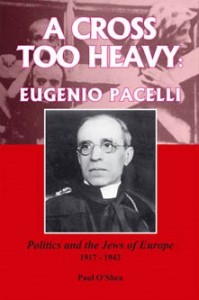 Paul O’Shea is one of the small group of Australian scholars who have become interested in the Catholic response to the traumatic events of the twentieth century, and particularly in the career of Pope Pius XII, as he sought to deal with the crises brought on by the totalitarian regimes of Europe. Like all of his predecessors, O’Shea suffers the handicap that many of the relevant documents have yet to be released from the Vatican archives, so despite his assiduous survey of Pius’ earlier life as a Vatican diplomat and later as Cardinal Secretary of State, we still have to acknowledge the tentative evaluation of all hypotheses about his war-time policies, and especially about his so-called “silence” concerning the victimization of the Jews of Europe.
Paul O’Shea is one of the small group of Australian scholars who have become interested in the Catholic response to the traumatic events of the twentieth century, and particularly in the career of Pope Pius XII, as he sought to deal with the crises brought on by the totalitarian regimes of Europe. Like all of his predecessors, O’Shea suffers the handicap that many of the relevant documents have yet to be released from the Vatican archives, so despite his assiduous survey of Pius’ earlier life as a Vatican diplomat and later as Cardinal Secretary of State, we still have to acknowledge the tentative evaluation of all hypotheses about his war-time policies, and especially about his so-called “silence” concerning the victimization of the Jews of Europe.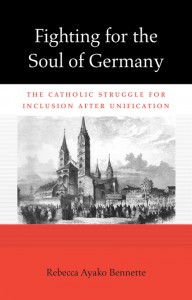 Bennette’s book is organized in two parts. The first, consisting of five chapters, relates the familiar story of the Kulturkampf with particular attention to events that served the construction of national identity and integration. The second, more original section is composed of four thematic chapters, devoted to the examination of “significant, sustained elements in the construction of Catholic national identity” (12); these elements include gender and femininity, schools and education, and the geographies of both Germany and Europe. Based on the evidence she offers, Bennette’s conclusions are difficult to disagree with: beginning immediately after German unification, German Catholics worked actively to build a national identity, one that differed from the mainstream Protestant version of Germanness and embraced their own religious particularity. The Kulturkampf not only failed to distance Catholics from their German identity; in fact, it solidified their attachment to the new nation and convinced them that they were an integral part of it.
Bennette’s book is organized in two parts. The first, consisting of five chapters, relates the familiar story of the Kulturkampf with particular attention to events that served the construction of national identity and integration. The second, more original section is composed of four thematic chapters, devoted to the examination of “significant, sustained elements in the construction of Catholic national identity” (12); these elements include gender and femininity, schools and education, and the geographies of both Germany and Europe. Based on the evidence she offers, Bennette’s conclusions are difficult to disagree with: beginning immediately after German unification, German Catholics worked actively to build a national identity, one that differed from the mainstream Protestant version of Germanness and embraced their own religious particularity. The Kulturkampf not only failed to distance Catholics from their German identity; in fact, it solidified their attachment to the new nation and convinced them that they were an integral part of it.